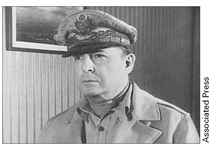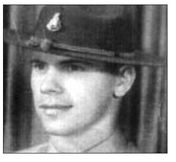War Stories II (8 page)
Authors: Oliver L. North

MARSMAN BUILDING
MANILA, PHILIPPINES
8 DECEMBER 1941
0330 HOURS LOCAL
MANILA, PHILIPPINES
8 DECEMBER 1941
0330 HOURS LOCAL
A little over half an hour after the attack on Pearl Harbor had begun, a Navy radio operator in the Asiatic Fleet headquarters in Manila received a message from Hawaii that the Pacific Fleet was under attack. The message concluded with the phrase “THIS IS NO DRILL.” The radioman immediately awakened his duty officer, who in turn had the message delivered to Rear Admiral W. A. Glassford, commander of the American Asiatic Fleet.
The admiral, awakened at 0415, read the message and instructed that a copy be sent via his aide to General Douglas MacArthur, the senior American officer in the Philippines.
MacArthur, shown the message at 0445, ordered a coded dispatch sent to his senior staff and subordinates alerting them of the attack on Pearl Harbor. At 0530 in the Philippines, MacArthur's headquarters received a second coded cable, this one from the War Department in Washington, advising him that Japan had launched an “unprovoked surprise attack” on Hawaii and that war was “likely.” More details were promised.
Â
General Douglas MacArthur

At 0800, news bulletins broadcast over shortwave and by standard commercial stations in Manilaâand heard at nearby Clark Fieldâinformed the population and MacArthur's troops, giving them a rough outline of what had happened at Pearl Harbor. By breakfast time, it seemed as though nearly everyone in the Philippines knew that the Japanese had attacked the Americans in Hawaii.
What they did
not
know was that in the predawn hours, about the time the first message came in from Pearl Harbor, hundreds of Japanese planes had taken off from bases in Formosa, en route to the Philippine Islands. The Japanese pilots flying the mission were worriedâbelieving that by the time they arrived over the Philippines, the Americans would be ready for them. But as it turned out, they needn't have been concerned. MacArthur never ordered a defensive alert.
not
know was that in the predawn hours, about the time the first message came in from Pearl Harbor, hundreds of Japanese planes had taken off from bases in Formosa, en route to the Philippine Islands. The Japanese pilots flying the mission were worriedâbelieving that by the time they arrived over the Philippines, the Americans would be ready for them. But as it turned out, they needn't have been concerned. MacArthur never ordered a defensive alert.
At about 0900, aircraft spotters on northernmost Luzon reported Japanese army bombers flying south toward Manila. U.S. planes were launched from Clark Field to intercept them, but the Japanese aircraft avoided a confrontation and detoured to another target, bombing barracks and other facilities at Baguio and Tuguegarao. At about 0930, the enemy bombers turned north and headed back to Formosa.
Lulled into believing that was the full extent of the Japanese attack, U.S. Army Air Corps officers at Clark Field ordered the fighters to return to base. Then, at 1130, as the U.S. aircraft were on the ground refueling, a second, much larger formation of Japanese bombers was picked up by radar. Fifteen minutes later, Colonel Alexander Campbell, the base warning officer, sent a Teletyped, coded message to Clark Field reporting that a huge formation of enemy planes was headed that way. For whatever reason, the message was never received.
U.S. fighter planes of the 34th Air Squadron from nearby Nielson Field were scrambled and sent to intercept the Japanese planes and to defend Clark Field. Planes from the 17th Air Squadron were launched to protect the Bataan Peninsula, while the 21st Air Squadron flew toward Manila. From its base at Iba, the 3rd Pursuit Squadron took off about noon to meet the Japanese formation over the South China Sea.
But none of the planes at Clark Field had been sent aloft. All except one of the B-17 bombers were still parked, wingtip to wingtip, on the airfield apron, when the first twenty-seven Mitsubishi bombers struck. Fifteen minutes later, another twenty enemy aircraft bombed and strafed Clark and Nichols Fields. And then a third wave of thirty-four Zeros dropped their munitions onâand then strafedâthe American B-17s and P-40s lined up below. The American planes, fully fueled and loaded with bombs and ammunition, ignited like a fireworks display as the Japanese bombs and incendiary cannon rounds found their mark.
American losses during the hour-long Japanese air assault were staggering, just as they had been in Hawaii. Though there were only fifty-three American fatalities and a hundred wounded, the damage and destruction to U.S. aircraft was catastrophic.
Although some in the press described the Japanese air strikes on the Philippines as a second Pearl Harbor, the similarities ended with the surprise air attack. Unlike those in Hawaii, the air attacks of 8 December were just the prelude to the onslaught on the Americans and our Filipino allies. The Japanese had come to stay.
As Admiral Glassford's diminished Asiatic Fleet prepared to flee south to link up with Dutch and British ships in the East Indies, Japanese ships were already landing the first of 43,000 soldiers from General Homma's 14th Imperial Army. Arrayed against them, without air support and cut off from resupply or reinforcement, were the 15,000 American and 80,000 poorly equipped Filipino troops led by General Douglas MacArthur. Among them were some remarkable heroes.

Dick Gordon volunteered on 5 August 1940 by walking into the U.S. Army recruiting center on Whitehall Street in downtown Manhattan. There, Gordon was offered his choice of where he wanted to go, so he chose the Philippinesâsuggested by the Army recruiter, who told him life there was pretty good. The recruiter had waxed eloquent about the beautiful tropical climate, warm breezes, and pristine beaches.
And that's just the way it was when Private Gordon arrived in the winter of 1940â1941. They drilled only until eleven-thirty in the morning, and stayed out of the hot afternoon sun, and, except for the midday heat, the weather was great, especially compared with the snow, wind, and sleet of New York. Private Gordon really thought he had it madeâthat is, until things began to take a decided turn in a different direction.
Lanky, six-foot-two, twenty-year-old Army Air Corps Private John Cook was a medic. He had enlisted in the Army Air Corps in Salt Lake City, Utah, and was assigned to the 90th Reconnaissance Squadron when the unit shipped out for the Philippines.
Corporal Ralph Rodriguez, Jr. was a twenty-three-year-old from New Mexico's 515th National Guard, in an Army anti-aircraft unit that had been dispatched to the Philippines after Congress extended the Selective Service Act just months earlier. All of his training was as a medic. When the Japanese invaded, he knew almost nothing about being a gunner or a rifleman.
Twenty-one-year-old Andy Miller from Nebraska was a private in the 19th Airborne Squadron of the Army Air Corps, stationed at Nichols Field. He regarded this as pretty good duty. The food was decent and the work wasn't too hard. It was a long way from home, but jobs were scarce in the Great Plains. But after the Japanese arrived, the bleak drought and Depression in Nebraska would start to look pretty good.

SERGEANT RICHARD GORDON, US ARMY
Assigned to U.S. Army Hospital
Manila, Philippines
8 December 1941
Assigned to U.S. Army Hospital
Manila, Philippines
8 December 1941

Things were great until around the summer of 1941, when it became a reality that the United States intended to defend the Philippine Islands in the event of war with Japan.
Troops began to arrive, ammunition began to arrive, and matériel began to arrive. And the men came. Many arrived in October and November
wearing winter clothing from the States. Once the U.S. forces began the buildup, training began to accelerate.
wearing winter clothing from the States. Once the U.S. forces began the buildup, training began to accelerate.
I guess that's when we first became aware of the fact that we would probably be at war with the Japanese real soon. But no one said, “I wanna go home,” becauseâquite franklyânobody ever believed that we weren't ready for them. From our point of viewâthe lowly private's point of viewâwe never thought anybody would have the nerve to attack the Philippines.
When they bombed Pearl Harbor in December, it was a shock... we thought it'd be the Philippines first. The talk in the barracks was that everybody in Washington expected the Philippines would be the first target of the Japanese.
When we heard the news of the attack on the radio that morning, a lot of the men asked, “Where's Pearl Harbor?” I happened to have come through Pearl Harbor, so I had a good idea of where it was. But, yeah, it came as a shock. Suddenly war was thrust upon us. And what was a nice, peaceful existence suddenly became a tough situation.
Immediately after Pearl Harbor, in fact within eight hours, the Japanese struck the Philippines and caught all of our planes sitting on the landing fields, just like they did in Pearl Harbor. They wiped out the Army Air Corps. That's when we knew we were in deep trouble, because now we had no airpower of any kind.
The Japanese people in Manila had trinket shops, which we would shop in on Sunday. But by Monday, 8 December, they were wearing uniforms and sniping at us.
About three days after they bombed Pearl Harbor and that first attack on the Philippines, they bombed us againâbut this time it was all over the place, so they moved us into Bataan, and much of the Filipino army was sent north by General MacArthur to defend against Japanese invasions. Within two days, the Japanese army just poured through. The Filipino army just wasn't ready. They weren't fit and hadn't been properly trained for combat.

Other books
Powdered Peril by Jessica Beck
Third and Long: A Sports Romance by Caitlyn Maxwell
Captive Moon by C. T. Adams, Cathy Clamp
Second Fiddle by Rosanne Parry
The Hockey Sweater and Other Stories by Roch Carrier
Qumrán 1 by Eliette Abécassis
Angel of Europa by Allen Steele
Touched (The Marnie Baranuik Files) by Aalto, A.J.
Rewired (The Progress Series) by Queau, Amy
Hers (Snowy Mountain Wolves) by Lovell, Christin
